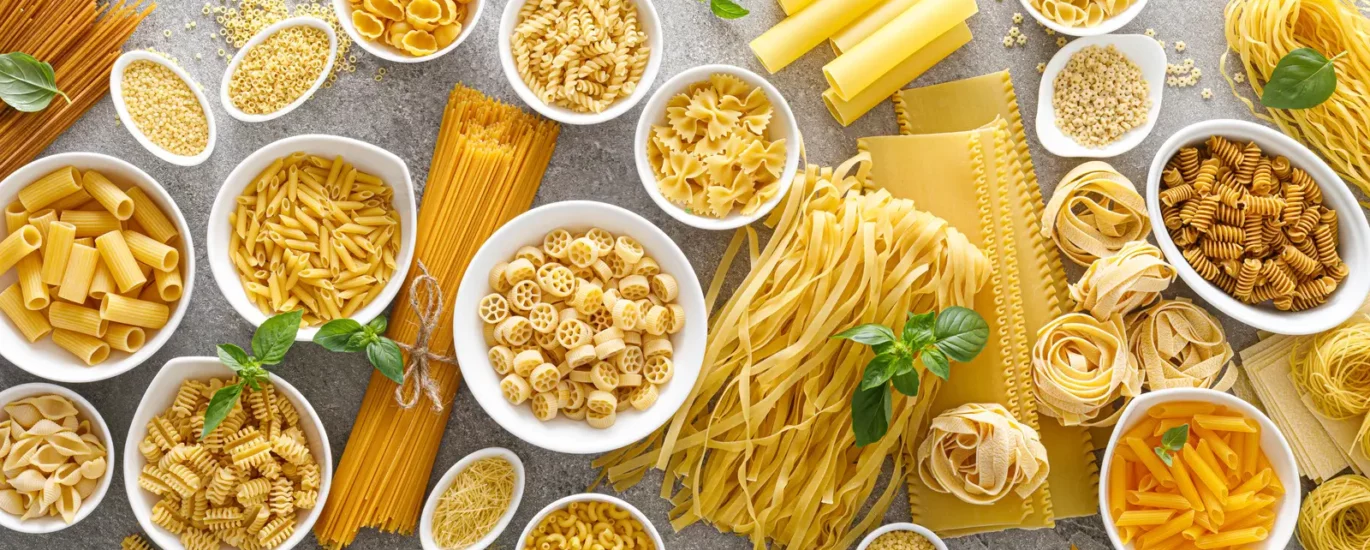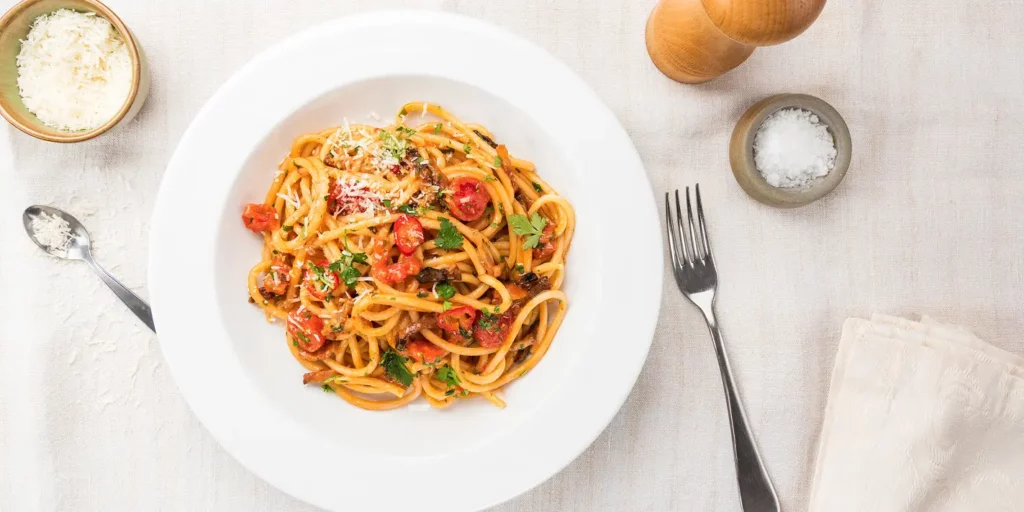

wordpress-seo domain was triggered too early. This is usually an indicator for some code in the plugin or theme running too early. Translations should be loaded at the init action or later. Please see Debugging in WordPress for more information. (This message was added in version 6.7.0.) in /home/sehatnagar.com/public_html/wp-includes/functions.php on line 6114
Let’s talk about pasta and its reputation when it comes to losing weight. Many people believe that pasta is a food that makes you gain weight. This idea has led to confusion and concerns among those trying to shed some pounds. The main reason behind pasta’s bad reputation is its high carbohydrate content. Carbohydrates have been blamed for causing weight gain in popular diets, and pasta has often been a casualty of these restrictions. This has left pasta lovers feeling deprived and unhappy. But is pasta really the enemy when it comes to weight loss? Can it be a part of a healthy diet?
In this article, we will explore the truth about pasta and its impact on weight loss. By looking at its nutritional value, understanding how it fits into a balanced diet, and considering healthier options, we can find out if pasta can be a friend rather than a foe in our weight loss journey. The goal of this article is to clear up any misunderstandings about pasta and provide helpful information based on scientific evidence. We will discuss how to prepare pasta? How it can be part of a well-rounded diet? We will also offer practical tips for including it in your weight loss plan. By the end, you will have a better understanding of whether pasta can be a good choice for you.
Pasta is a beloved food worldwide, but to understand its impact on weight loss, it’s important to delve into its nutritional composition. Let’s explore the basic components of pasta and how they can fit into a healthy diet.
Carbohydrates are the primary macronutrient present in pasta. They provide energy and helpful in weight gain. However, carbohydrates are an essential part of a balanced diet, and the key lies in consuming them in appropriate amounts. Pasta is a significant source of complex carbohydrates, which are digested more slowly and provide sustained energy.
Fiber is another vital component of pasta that can positively impact weight loss. While regular pasta made from refined grains may have lower fiber content, whole grain and whole wheat pasta varieties offer a substantial fiber boost. Fiber promotes feelings of fullness, aids digestion, and helps regulate blood sugar levels.
Protein content in pasta is relatively modest compared to other protein-rich foods like meat or legumes. However, when combined with protein sources such as lean meats, poultry, fish, or plant-based options like beans and tofu, pasta can contribute to a balanced meal. Protein promotes satiety and helps preserve lean muscle mass during weight loss, making it an important element of a successful weight loss plan.
Fat content in pasta is generally low, especially if the sauce or toppings are kept light. However, it’s worth considering the type of fat used when preparing pasta dishes. Opting for healthy fats like olive oil or avocado instead of saturated or trans fats can contribute to a nutritious meal.
Choosing whole grain or whole wheat pasta over refined pasta varieties offers additional nutritional benefits. Whole grain options retain the bran and germ, providing more fiber, vitamins, minerals, and antioxidants. This can help regulate digestion, control hunger, and support overall health.
One of the most prevalent misconceptions surrounding pasta is the belief that it inevitably leads to weight gain. However, it’s essential to dispel this myth and understand the true relationship between pasta and weight loss. The notion that pasta alone is responsible for weight gain oversimplifies the complex process of weight management. Weight loss ultimately boils down to achieving an energy imbalance, where the calories consumed are fewer than the calories expended. It’s the overall calorie intake, rather than a single food item, that determines whether weight loss or weight gain occurs.
When it comes to weight loss, the key is to create a calorie deficit by consuming fewer calories than your body needs. While pasta does contain carbohydrates, which are a source of energy, it’s important to consider the portion size and overall calorie intake in the context of a balanced diet. By controlling portion sizes, pasta can be part of a successful weight loss plan. Energy density is another concept that plays a role in understanding pasta’s impact on weight loss. Energy density refers to the number of calories present in a given volume of food. Low-energy-density foods provide fewer calories for the same volume, which can help promote feelings of fullness while consuming fewer calories overall.
Pasta dishes can vary in energy density depending on the ingredients and preparation methods. For example, a pasta dish laden with heavy cream-based sauces, excessive cheese, or high-fat meats may have a higher energy density, leading to a higher calorie intake. On the other hand, incorporating plenty of vegetables, lean proteins, and lighter sauces can create a lower-energy-density pasta meal. By choosing pasta dishes with a lower energy density, you can enjoy a larger volume of food while keeping your calorie intake in check.

Pasta should not be viewed as a magical weight loss food. While it can be part of a healthy weight loss diet, the overall dietary pattern, portion control, and consideration of energy balance are key factors. A diet rich in a variety of whole foods, including fruits, vegetables, lean proteins, and healthy fats, along with regular physical activity, is crucial for achieving sustainable weight loss.
When it comes to a balanced diet, pasta can play a valuable role, especially in a calorie-controlled approach to weight loss. Let’s explore the benefits of including pasta in diet plan and how we can pair it with nutrient-dense ingredients for optimal nutrition. Including pasta in a balanced, calorie-controlled diet offers several advantages. First and foremost, pasta is a versatile and satisfying food that can provide a sense of comfort and enjoyment during the weight loss journey. By incorporating pasta into your meals, you can help prevent feelings of deprivation and maintain dietary adherence.
Pairing pasta with nutrient-dense ingredients is key to creating a balanced and nourishing meal. By adding an array of colorful vegetables, you can increase the fiber, vitamin, and mineral content of your pasta dishes while keeping the calorie density in check. Vegetables like spinach, broccoli, bell peppers, and cherry tomatoes are excellent choices that add both flavor and nutritional value to pasta-based meals.
airing pasta with nutrient-dense ingredients is key to creating a balanced and nourishing meal. By adding an array of colorful vegetables, you can increase the fiber, vitamin, and mineral content of your pasta dishes while keeping the calorie density in check. Vegetables like spinach, broccoli, bell peppers, and cherry tomatoes are excellent choices that add both flavor and nutritional value to pasta-based meals.
Lean proteins are another essential component to include when enjoying pasta. Adding grilled chicken, turkey, fish, or plant-based protein sources like beans, lentils, or tofu to your pasta dishes helps increase satiety and supports muscle preservation during weight loss. Proteins also require more energy to digest, which can boost your metabolism and aid in weight management.
Healthy fats are an important part of a balanced diet and can enhance the nutritional profile of pasta meals. Incorporating sources of monounsaturated fats, such as olive oil, avocados, or nuts, can add flavor and promote satiety. These fats also provide essential fatty acids and fat-soluble vitamins, contributing to overall nutritional adequacy.
To give you an idea of pasta-based meals that promote weight loss while ensuring adequate nutrition, consider the following examples:
These examples demonstrate how pasta can be incorporated into meals that prioritize nutrient density, portion control, and a balance of macronutrients. By focusing on whole grain or alternative pasta options, incorporating plenty of vegetables, lean proteins, and healthy fats, you can create satisfying and nutritious pasta-based meals to support your weight loss goals. Remember, individual preferences and dietary restrictions should be considered when choosing ingredients for your pasta dishes.
When it comes to weight loss, incorporating alternative pasta options can provide additional nutritional benefits compared to traditional refined pasta. Let’s explore some of these alternatives available in the market, discuss their potential advantages in terms of fiber and protein content, and offer cooking tips and recipe ideas to make the most of these healthier pasta options.
When cooking with these healthier pasta alternatives, it’s essential to pair them with nutrient-dense ingredients to create well-rounded and satisfying meals. Here are some recipe ideas:
By incorporating these healthier pasta alternatives and exploring creative recipe ideas, you can enjoy satisfying pasta dishes while supporting your weight loss goals. Remember to adjust cooking times and techniques to accommodate the specific characteristics of each alternative pasta type. Experiment with different flavors, seasonings, and ingredients to find combinations that suit your preferences and dietary needs.
When it comes to incorporating pasta into a weight loss plan, it’s important to adopt strategies that promote portion control, mindful eating, and regular physical activity. Here are some tips to help you make the most of pasta while working towards your weight loss goals:
By implementing these tips, you can enjoy pasta as part of your weight loss plan while maintaining portion control, practicing mindful eating, and incorporating regular physical activity.
In conclusion, pasta can indeed be a part of a healthy weight loss diet. Contrary to popular belief, pasta itself is not inherently fattening. It is important to consider portion control, choose whole grain or alternative pasta options, and pair pasta with nutrient-dense ingredients like vegetables and lean proteins. Incorporating regular physical activity and practicing mindful eating techniques further enhance weight loss efforts. Remember, individual preferences, dietary restrictions, and overall diet quality play a crucial role in determining the suitability of pasta in your weight loss plan. For personalized advice, consult with a healthcare professional or registered dietitian.
Read Also:
Is Cabbage Good For Weight Loss?